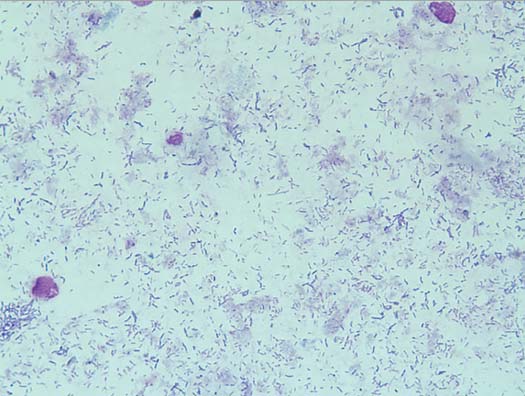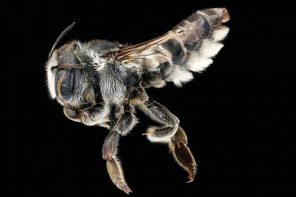By: M.E.A. McNeil
Probiotic: pro means for, biotic means life. For life. Yes, we’re for life. More life, more better, right? Maybe. Maybe not.
For most of history, microbes were hidden from sight – even after Leeuwenhoek glimpsed them through his microscope 350 years ago. When, in the 1850s, Pasteur proved that germs make us sick, we learned only the harm. Penicillin was discovered seventy years later, and we armed with antibiotics. After the discovery of DNA by Watson and Crick in 1953, it was genes, we came to believe, that drove our biological destiny. Then we learned that our bodies are teeming with microorganisms – teaming is a better word. Although health is surely influenced by our genes, it could be affected even more powerfully by our microbiome – bacteria mostly, but also viruses and fungi, including a variety of yeasts. So we are less like a set of genetic instructions than a farm. And our microorganisms have their own DNA; their microorganisms have their own genes, too. In sum, they are not our guests but symbionts – partners, coconspirators, give or take some frenemies.
The importance of microbial communities in the health of animals, from humans to insects, has become recognized only recently, now that tools for studying microorganisms have become much more powerful. The arrival of DNA sequencing technology has revolutionized scrutiny of this complex and dynamic network. “We are in that beautiful, euphoric, heady, early period,” said microbiologist David Relman of Stanford University School of Medicine.
But once the news spread that we are ecosystems with legs, we ran with what little we understood to create shelves of nostrums for managing our biotic legions. And what’s good for ourselves must also be good for our dogs, horses and pigs. And our bees.
All animals have biomes particular to themselves, and bees are no exception. Two probiotic products are marketed especially for bees: Super DFM, from Strong Microbials, and Pro DFM from Mann Lake. (A third product, Durvet, from PBS Animal Health, has been discontinued.) Super DFM and Pro DFM list the same eight microbes in their contents, and Pro has one additional bacterium plus several yeasts.
What are these products? Do our bees need them? Field testing results are not available for either one, nor are there published scientific peer-reviewed papers evaluating them. How do we find out?
Entomologist Marla Spivak, at The University of Minnesota, asked a grad student in her lab to check the ingredients of these products against what is in the natural bee gut biome. There was no match, so further investigation was set aside in favor of a more promising pursuit for supporting the bee gut microbiome. To look further into these products, she said, “call Nancy.”
The Pioneering Researcher
Nancy Moran is the preeminent expert in insect and bacterial genomics, recognized as a member of the National Academy of Sciences and a MacArthur Fellow, co-founder of the Yale Microbial Diversity Institute and professor at the University of Texas, Austin. Her work on the symboses in the microbiomes of insects has traced the evolution of some back 270 million years.
“We were the crazy people” for thinking symbiosis was so important, 25 years ago, she said. Her team’s early work found that the honey bee gut harbors eight species of bacteria not retrieved from other environments, and that every honey bee around the world has the same set. This distinct community in the adult gut is stable but dynamic. The resident microbial species appear to have undergone such long term coevolution with honey bees that the adult gut is their sole ecological niche. Most of the bacteria are host-restricted, that is to say absent outside adult guts, just passed from bee to bee. Of the billion bacterial cells in the gut of the honey bee adult worker, most are in the hindgut, with very small numbers in the foregut (honey stomach or crop).
The Moran lab demonstrated the vital importance of these bacteria by isolating young microbiome-free pupae before emergence and observing their resulting failures as they matured. As controls, their sisters emerged into the colony’s naturally-endowed microbiome and were supported in health by their acquired metabolic partners.
What does this microbiome do? “The host and the symbiont communicate in ways we don’t understand,” said Moran, and she thinks that will take a lifetime to unravel. But it is known that some strains of bacteria associated with honey bees have antimicrobial properties. Genome sequencing suggests that they also play roles in nutrition, digestion, and potential defense against pathogens.
For an example, Moran’s lab isolated 42 strains of the core bee gut symbiont Gilliamella apicola and sequenced their genomes. Beyond the genetic similarity in the strains, they found extensive variation related to carbohydrate metabolism. It was significant to find that some strains of G. apicola were found to break down carbohydrates present in the bee diet that are toxic to bees; others are able to utilize glucose, fructose, and mannose. A single strain does not fulfill all of those functions.
Should we be adding to that? Moran said that it is commonly believed that a diverse microbiota is good, but that has not been experimentally tested. In bees, species-level diversity is naturally low, while strain diversity is high. But “it is not clear that supplementing the typical bacteria already present will improve colony health. Potentially, the strains present in particular colonies have already been selected to perform well under local conditions.”
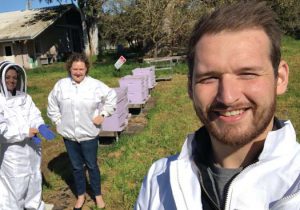
Elina Nino, U C Davis Extension Apiarist (center) and Lab Assistant Robin Lowry (left) oversee a field test for a bee probiotic at the Harry H. Laidlaw Jr. Honey Bee Research Facility. The product was developed by a team at University of Western Ontario in Canada, including PhD candidate Brendan Daisley (foreground) who wrote the peer-reviewed paper on the initial lab work. Photo courtesy Brendan Daisley.
What’s in the Bag?
Nancy Moran looked at the list of bacteria in Super DFM and Pro DFM. “These are not normal bacteria in the bee gut. I don’t think they will colonize, and if they did colonize I think that’s not good. The bees encounter all kinds of bacteria, but the gut biome stays the same. The bees with altered microbiomes are mostly sick. What we want is for the bee to keep normal microbiota.”
“I can see why they [the commercial companies] chose these bacteria. To me these are standard bacteria, easy to grow. These bacteria in the products are very widespread, for example, B. subtilis. None of the actual bee bacteria grow under atmospheric conditions; they are anoxic (without oxygen, with one exception). For a long time, no one had cultured them because they require special culturing conditions. So these bacteria that they chose for the commercial products are grown under full oxygen, which is easy in comparison. I guess anyone can put anything in bee food.”
“Maybe some [bacteria in the commercial products] facilitate some benefit; I don’t know what that might be. I guess it’s possible, but I would be surprised to see strong positive results. The studies need to be done by scientists and other reviewers to determine if this is robust. I like to see data in a peer-reviewed journal.”
There is a field study published in Environmental Microbiology: Stephan et al., “Honeybee-Specific Lactic Acid Bacterium Supplements Have No Effect on American Foulbrood-Infected Honeybee Colonies,” July 18, 2019.

Oregon State University honey bee researcher Ramesh Sagili is undertaking a
field study of two probiotic products that are on the market. Photo by Lynn etchum,
Oregon State University
The Evidence in Favor
Strong Microbials opens with the claim that their product is a “Bacteria Blend for All Species of Honey Bees.” All of the species? No, surely they don’t mean all of them; they must mean only one species, Apis mellifera and all its subspecies. Just a stumble, but you wonder.
Strong Microbials does cite research papers for some of its bacterial ingredients in Super DFM. They could be stronger. For example, of the test cited to support the inclusion of B. lichenifromis, Moran said, “It’s only a lab study; you can’t conclude it will work from that.” The research cited for Bacillus pumilis tests it against American Foulbrood and then excludes it from its summary of best antagonists.
A paper is cited from The Journal of Economic Entomology to support Lactobacillus plantarum. However an author of this study, Jay Evans, Research Leader at the USDA Beltsville Bee Lab, said: “Much more needs to be done with the science. How long do the probiotics persist – a day, a season? Or do they just pass through [the bees]? People are spending a lot of money without knowing what it is.” He did not dismiss the possibility of benefit, saying there is work showing some positive results for putting benign bacteria into bees. But questions remain.
In any case, the proposed benefit for each ingredient in Super DFM is accompanied by the required disclaimer: “This statement has not been evaluated by the FDA. This product is not intended to diagnose, treat, cure, or prevent any disease.”
The logic in the market for human probiotics is that if a strain is potentially beneficial on its own, it will be that more beneficial combined with others. “That argument is fallacious, and potentially very troublesome,” said Michael Fishbach, a professor of bioengineering at Stanford. “Right now, the standard for evidence is disgustingly low.”
The second probiotic product, Pro DFM, posts that it helps improve bee colony health, positively affects nurse bees’ vitellogenin reserves, aids in fermentation and digestion of beebread and has no harmful residues. The website’s “More Information” page is down and the company has not responded to inquiry. Moran speculates that the yeasts in the formula may be intended as a nutritional supplement.
As for either product, she said, “I’m skeptical. I hate to see people waste money. I wouldn’t buy it.”
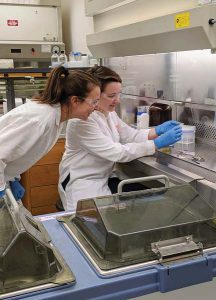
Oregon State University microbiologist Maude David (left) in the lab with her student Grace Deitzler examining a honey bee under the biohood. They are working in collaboration with OSU researcher and extension apiarist Ramesh Sageli to test two probiotic products that are on the
market. Photo courtesy of Grace Deitzler
The Benefit of the Doubt
“I’ve been getting calls asking about these probiotic products,” said entomologist Ramesh Sagili, Associate Professor at Oregon State University and respected researcher. “We have done many studies on honey bee health, it is our focus,” he said. “I’m enthusiastic about honey bee nutrition, but people are selling these probiotics, and there is no proper research. There are a lot of claims. There is some anecdotal evidence, but I take it with a grain of salt. Where are the publications? I have not seen published research on these commercial products. They are bombarding people with samples. It’s very murky with these companies. There is no peer-reviewed science on commercially available probiotics [for bees].”
Sagili’s appointment includes extension work where he confers closely with beekeepers, and he plans to give them some scientific answers by doing studies on the products. He is collaborating with OSU microbiologist Maude David, Assistant Professor in the colleges of Science and Pharmacy whose lab has begun culturing the products.
“This is an emerging field,” said Sagili. “People don’t yet have enough understanding of the science at this point. How did these people decide what to include – by inferences from papers showing specific strains to have some effects? It is an agreed fact that the functional roles of these bacteria are not well understood. These products assume that they are all beneficial. We don’t know the mechanisms, whether they act, for example, on the metabolism, affecting the digestion, or on the immune system. If we see some change, how does it work?”
Sagili has mixed preliminary results from a small trial of Super DFM, done last year for the purpose of establishing the protocol. They plan a larger study in April or May beginning with a cage study in the lab in order to ensure delivery of the substance. The next step will be in the field where it is more difficult. The team has a lot of questions about these bacteria. They will examine the effects on Nosema and indirect effects on bee physiology such as the protein levels in the hypopharyngeal gland and midgut enzyme levels, as well as longevity in general.
A second trial of both products, funded by The California Beekeepers Association, is being done by Bee Informed Project Tech Transfer Team member Matt Hoepfinger.
Another One
Not yet on the market is another probiotic for bees intended to stimulate immune response or attack pathogens. It is developed by a team at University of Western Ontario in Canada lead by microbiologist Gregor Reid and Graham Thompson, a biologist specializing in social behavior of insects. The product is unlike the two commercially available in several ways. It contains different ingredients: Lactobacillus plantarum Lp39, Lactobacillus rhamnosus GR-1, and Lactobacillus kunkeei BR-1 and, as indicated by the letters and numbers, particular strains are named. These numbers are important because species name is not enough to uniquely identify the organism.
The initial lab study has been published in the ISME Journal in a peer-reviewed paper. Lead author on the paper, PhD candidate Brendan Daisley, wrote, “The results from our study demonstrated that probiotic supplementation could increase the expression of a gene called Defensin-1– a key antimicrobial peptide shown to play a pivotal role in honey bee defense against P. larvae [American Foulbrood] infection.” A disclaimer calls it like it is: “These results should be cautiously interpreted as in vitro rearing of honey bee larvae cannot perfectly emulate the highly complex microbial dynamics, nor the organized social feeding behaviours that are present in a hive.” Fair enough.
Moran is curious. “Kunkeei is the only one [of the three bacteria in the product] found in the bee gut. It is common in nectar, on plants and in the hive environment, but in the bee it is found in the foregut, less than 1% [of the total]. Possibly it can ferment sugar or help digestion or perhaps it dampens the growth of other bacteria. In that sense it is slightly more possible as a component of a supplement. But we look more at the hindgut; Kunkeei is in the foregut.” The American Type Culture Collection, a library of microorganisms, notes this strain of kunkeei was isolated from a healthy honey bee hive and was routinely cultured anaerobically.
Elina Niño’s lab at U.C. Davis has completed an initial field study using the product in hives with nutritional patties or spray. At this writing, results have not been processed. Another field study, in Eastern Canada, will take place next summer. The formulation has been patented through Seed Labs, but, said Reid, “The company’s patents for the probiotics will be royalty-free and available to any beekeepers that want to use them.”
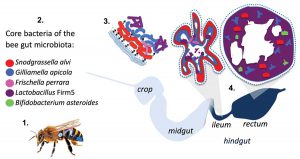
1. The position of the bee gut in the honey bee. 2. Five of the core bacteria in the bee gut. 3. A color-coded illustration of how these bacteria align along the gut wall and indications of their symbioses. 4. A diagram of the bee gut from front to back, indicating the concentration of the bacteria in the hindgut, the layering in the ileum and proliferation in the rectum. Illustration courtesy of Moran Lab, U. Texas Austin.
Alternatively
Consider the possibly of establishing the effects these probiotic products are aiming for without need for them. A paper is forthcoming from the Spivak Lab showing enhancement of the bee microbiome in the presence of propolis.
In the meantime, it’s wait and see to find out more about these products. Some new research data is forthcoming, but long-term effects will take years – if anyone can monitor them that long.
Propolis we have already.
M.E.A. McNeil is a Master Beekeeper and journalist. Some of her articles can be found at MeaMcNeil.com, and she can be reached at Mea@MeaMcNeil.com.






